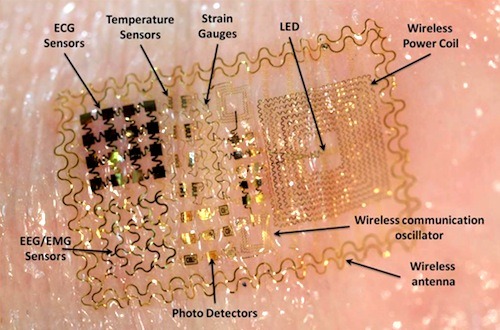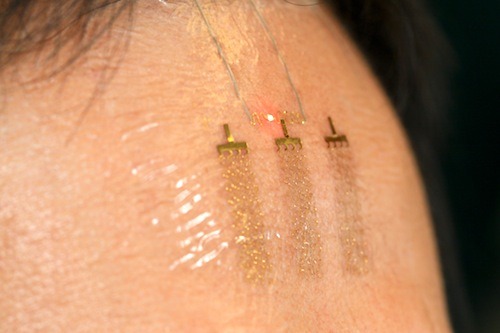~~~~~~~~~~~~~~~~~~~~~~~~~~~~~~~~~~~~~~~~~~~~~~~~~~~~~~~~~~~~~~~~
The Raelian Movement
for those who are not afraid of the future : http://www.rael.org
~~~~~~~~~~~~~~~~~~~~~~~~~~~~~~~~~~~~~~~~~~~~~~~~~~~~~~~~~~~~~~~~
Contributed by Mike Bennett
Source: http://txchnologist.com/post/43496630304/temporary-tattoos-could-make-electronic-telepathy

Temporary electronic tattoos could soon help people fly drones with only thought and talk seemingly telepathically without speech over smartphones, researchers say.
 Electronic telekinesis? Digital telepathy?
Electronic telekinesis? Digital telepathy?

for those who are not afraid of the future : http://www.rael.org
~~~~~~~~~~~~~~~~~~~~~~~~~~~~~~~~~~~~~~~~~~~~~~~~~~~~~~~~~~~~~~~~
Contributed by Mike Bennett
Source: http://txchnologist.com/post/43496630304/temporary-tattoos-could-make-electronic-telepathy
Temporary Tattoos Could Make Electronic Telepathy, Telekinesis Possible

February 19th, 2013
Temporary electronic tattoos could soon help people fly drones with only thought and talk seemingly telepathically without speech over smartphones, researchers say.
Commanding machines using the brain is no longer the stuff of science fiction. In recent years, brain implants have enabled people to control robotics using only their minds, raising the prospect that one day patients could overcome disabilities using bionic limbs or mechanical exoskeletons.
But brain implants are invasive technologies, probably of use only to people in medical need of them. Instead, electrical engineer Todd Coleman at the University of California at San Diego is devising noninvasive means of controlling machines via the mind, techniques virtually everyone might be able to use.
His team is developing wireless flexible electronics one can apply on the forehead just like temporary tattoos to read brain activity.
“We want something we can use in the coffee shop to have fun,” Coleman says.
The devices are less than 100 microns thick, the average diameter of a human hair. They consist of circuitry embedded in a layer or rubbery polyester that allow them to stretch, bend and wrinkle. They are barely visible when placed on skin, making them easy to conceal from others.
The devices can detect electrical signals linked with brain waves, and incorporate solar cells for power and antennas that allow them to communicate wirelessly or receive energy. Other elements can be added as well, like thermal sensors to monitor skin temperature and light detectors to analyze blood oxygen levels.
Using the electronic tattoos, Coleman and his colleagues have found they can detect brain signals reflective of mental states, such as recognition of familiar images. One application they are now pursuing is monitoring premature babies to detect the onset of seizures that can lead to epilepsy or brain development problems. The devices are now being commercialized for use as consumer, digital health, medical device, and industrial and defense products by startup MC10 in Cambridge, Mass.

In past studies, Coleman’s team found that volunteers could use caps studded with electrodes to remotely control airplanes and flew an unmanned aerial vehicle over cornfields in Illinois. Although the electronic tattoos currently cannot be used to pilot planes, “we’re actively working on that,” Coleman says.
These devices can also be put on other parts of the body, such as the throat. When people think about talking, their throat muscles move even if they do not speak, a phenomenon known as subvocalization. Electronic tattoos placed on the throat could therefore behave as subvocal microphones through which people could communicate silently and wirelessly.
“We’ve demonstrated our sensors can pick up the electrical signals of muscle movements in the throat so that people can communicate just with thought,” Coleman says. Electronic tattoos placed over the throat could also pick up signals that would help smartphones with speech recognition, he added.
Invasive brain implants remain better at reading brain activity, Coleman notes.
But neuroscientist Miguel Nicolelis at Duke University Medical Center says there is a need for noninvasive technologies such as these for the brain. “People will want to navigate environments just by thinking, or play games just by thinking,” says Nicolelis, who did not take part in this research.
Coleman detailed his group’s most recent findings in Boston on Feb. 17 at the annual meeting of the American Association for the Advancement of Science.

Top Image: Image of a piece of electronics with physical properties, i.e. stiffness, bending rigidity, thickness and mass density, matched to the epidermis. Such ‘epidermal’ electronic systems seamlessly integrate and conform to the surface of the skin in a way that is mechanically invisible to the user. The devices have the potential to provide a range of healthcare and non-healthcare related functions. Image courtesy John A. Rogers.
Middle Image: The Neural Interaction Lab led by UC San Diego bioengineering professor Todd Coleman is working with Mary J. Harbert, MD, director of neonatal neurology UCSD and Rady Children’s Hospital, to study the use of stamp-sized wearable patches of tiny circuits, sensors, and wireless transmitters to replace bulky wires currently used to monitor newborns in the neonatal ICU. The greatest advance in the neonatal ICU for premature babies has been stabilizing the heart and lung. But nowadays, experts are increasingly focusing on brain injury: under-development of the cerebral vasculature, hemorrhage, and seizures commonly occur in premies. If left unchecked, they can lead to epilepsy or cognitive development problems. Image courtesy Todd Coleman/UCSD.
Bottom Image: The Neural Interaction Lab led by UC San Diego bioengineering professor Todd Coleman is working with Ricardo Gil da Costa, PhD, at the Salk Institute to examine the use of wearable flexible electronics on the forehead to monitor congnitive impairment with systems that are minimally obtrusive. These patches of sensors monitor electrical rhythms of the brain and can wirelessly transmit information optically (via LEDs) or electromagnetically (via flexible antennas) to provide quantitative measures of attentional modulation that co-vary with the progression of dementia, Alzheimer’s disease, depression, and schizophrenia. These minimally obtrusive wearable electronics provide promise for future clinical brain monitoring applications for hospitals and laboratories, outpatient clinics or even at home. Image courtesy Todd Coleman/UCSD.
--
~~~~~~~~~~~~~~~~~~~~~~~~~~~~~~~~~~~~~~~~~~~~~~~~~~~~~~~~~~~~~
"Ethics" is simply a last-gasp attempt by deist conservatives and
orthodox dogmatics to keep humanity in ignorance and obscurantism,
through the well tried fermentation of fear, the fear of science and
new technologies.
There is nothing glorious about what our ancestors call history,
it is simply a succession of mistakes, intolerances and violations.
On the contrary, let us embrace Science and the new technologies
unfettered, for it is these which will liberate mankind from the
myth of god, and free us from our age old fears, from disease,
death and the sweat of labour.
Rael
~~~~~~~~~~~~~~~~~~~~~~~~~~~~~~~~~~~~~~~~~~~~~~~~~~~~~~~~~~~~~~
Tell your friends that they can subscribe to this list by sending an email to:
subscribe@rael-science.org
- - -
ไม่มีความคิดเห็น:
แสดงความคิดเห็น